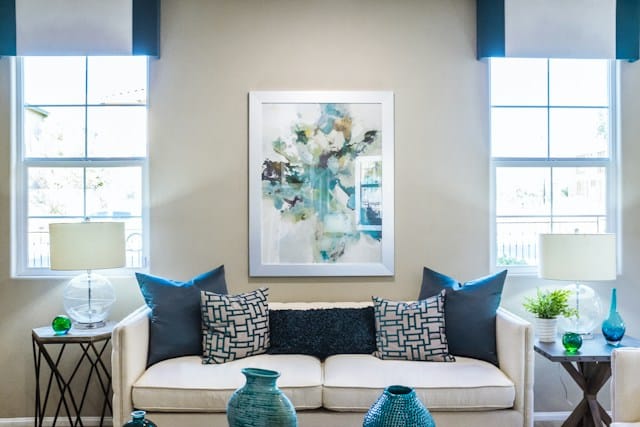Current trends in real estate interior design

The landscape of interior design is ever-changing, with new styles, color schemes, and furniture designs emerging each year. These trends are heavily influenced by various factors such as cultural changes, technological advancements, and even global events. In the realm of real estate, interior design plays a crucial role. It’s not just about making spaces beautiful, but also about improving functionality, enhancing comfort, and maximizing the use of space. In this article, we will explore the current trends in real estate interior design, including popular color choices, furniture styles, lighting techniques, and more.
Emphasis on Natural Elements
The year 2023 has seen a distinct shift towards natural elements in interior design. This style speaks to a desire for a more sustainable and eco-friendly lifestyle, encouraging us to bring the outdoors inside.
Lire également : Real estate negotiation techniques
The use of natural elements sees a surge in popularity, with designers incorporating materials such as wood, stone, and plants into their designs. This trend goes beyond just plants and wooden furniture. It includes the use of natural light, an aspect often overlooked but highly significant in setting the mood of a room. Homes designed with large windows, glass walls, and skylights will not only benefit from natural lighting but also create an illusion of more space.
Live edge wood, a popular design trend, embraces the natural form of wood, promoting a rustic yet sophisticated feel. Bamboo, wicker, and rattan furniture are also making a comeback, adding a touch of nature to homes.
Dans le meme genre : Successful property investment in St Martin de Belleville: practical advice and winning strategies
White is the New Black
In the world of interior design, color trends come and go. However, the color white has proven to be timeless. Designers have begun to appreciate the simplicity, purity, and versatility of white in creating elegant and sophisticated living spaces.
White makes rooms appear larger and brighter, an essential feature in real estate as potential buyers often look for homes with spacious rooms. Using white for walls, floor, and furniture can help create a seamless space, providing a blank canvas that allows homeowners to experiment with other colors and patterns.
In kitchens, white cabinets paired with marble countertops have become a classic choice, exuding a clean and modern look. In living rooms, white sofas or chairs can serve as the perfect centerpiece, complemented by colorful pillows or throws to add a touch of vibrancy.
The Rise of Multifunctional Spaces
With the ongoing global pandemic and the rise of remote work, homes have evolved from being just a place to eat and sleep. They have become multifunctional spaces where people work, learn, exercise, and entertain.
Interior designers are responding to this change by creating flexible layouts and incorporating multifunctional furniture. For instance, kitchen islands can serve as a dining table, a workspace, or a place for socializing. Living rooms can transform into home offices with the use of foldable desks or storage ottomans that can work as extra seating, a coffee table, or storage space.
This trend also paves the way for open floor plans, where the kitchen, dining, and living areas are combined to form one large multifunctional space. This style encourages more social interaction, boosts natural light, and enhances the sense of spaciousness.
Focus on Texture and Layering
Texture and layering have become hot topics in interior design. While color can draw the eye, texture and layering add depth and dimension to a room, making it visually interesting.
Designers are experimenting with a variety of materials and patterns to create a rich tactile experience. Velvet upholstery, macrame wall hangings, woven rugs, and knitted throw blankets are popular choices, adding a touch of coziness and warmth to living spaces.
In the kitchen, designers are mixing and matching different finishes and materials. Stainless steel appliances can be paired with marble countertops and wooden cabinets, creating a layered look that is both chic and rustic.
Smart and Sustainable Homes
In line with the increased focus on sustainability, designers are incorporating energy-efficient features and smart technologies into homes. From solar panels and LED lighting to energy-saving appliances, these features not only help conserve the environment but also reduce electricity bills.
Smart homes are also becoming increasingly popular. This trend involves the use of devices, appliances, and systems that connect into a common network, allowing homeowners to control them remotely via their smartphones or computers. This includes smart lighting systems, thermostats, security systems, and even smart kitchen appliances.
Interior design trends are constantly evolving, and these are just some of the current trends shaping the real estate industry. By embracing these trends, we can create homes that are not only aesthetically pleasing but also comfortable, functional, and sustainable.
The Revival of Art Deco
Art Deco, a design trend that reached its peak in the 1920s, has made a stunning comeback in the realm of real estate. Characterized by geometric shapes, bold colors, and lavish ornamentation, this style is all about glamour and sophistication.
The revival of Art Deco is seen in various aspects of interior design. For instance, furniture pieces with geometric lines and rich colors are becoming increasingly popular, providing a striking contrast to the prevalent trend of neutral shades. The use of bold patterns, such as chevron and sunburst, in wallpapers, rugs, and textiles add a touch of extravagance to living spaces.
Lighting plays a vital role in the Art Deco style. Chandeliers and pendant lights with geometric shapes and intricate designs are used to draw attention and create a focal point in a room. Besides, staple materials of the Art Deco era, such as chrome, brass, and glass, are also making a reappearance in contemporary designs.
A photo credit to Getty Images showcases a stunning dining room with an Art Deco-inspired design. The room boasts a black and white chevron-patterned floor, a brass chandelier with geometric design elements, and bold, vibrant artwork. These elements blend seamlessly to create a space that is striking, luxurious, and undoubtedly Art Deco.
Boutique-style Bathrooms
Bathrooms are no longer just functional spaces; they have become an extension of a home’s overall design theme. The current trend leans towards boutique-style bathrooms, which prioritize aesthetics, luxury, and relaxation.
Interior designers are utilizing high-quality materials and elegant fixtures to create a spa-like ambiance. Features such as freestanding bathtubs, spacious walk-in showers with rainfall showerheads, and heated floors are becoming more common in bathroom designs.
Color and texture play a significant role in creating a boutique-style bathroom. Designers are moving away from the traditional all-white bathroom and experimenting with darker, moodier colors to create a more relaxing and serene atmosphere. Natural materials like wood and stone are also being used to add warmth and character to the space.
An image credit to Styled Staged & Sold illustrates a boutique-style bathroom with an elegant freestanding bathtub, a spacious walk-in shower, and a floating vanity unit. The walls are painted in a moody shade of blue, creating a calming and serene environment ideal for relaxation.
In Conclusion
The current trends in real estate interior design are diverse and exciting, reflecting the evolving needs and preferences of homeowners. By incorporating natural elements, versatile color schemes like white, and the use of texture and layering, designers can create spaces that are not only stylish but also functional and sustainable. The rise of multifunctional spaces is testament to the adaptability of design in response to changes in lifestyle, while the revival of Art Deco and the trend towards boutique-style bathrooms demonstrate the cyclical nature of design trends.
Regardless of the changing trends, the ultimate goal of interior design in real estate remains the same: to create homes that are comfortable, aesthetically pleasing, and reflective of the homeowner’s personal style. It’s an exciting time to be involved in interior design, whether as a professional designer, a real estate agent, or a homeowner looking to update your space.
